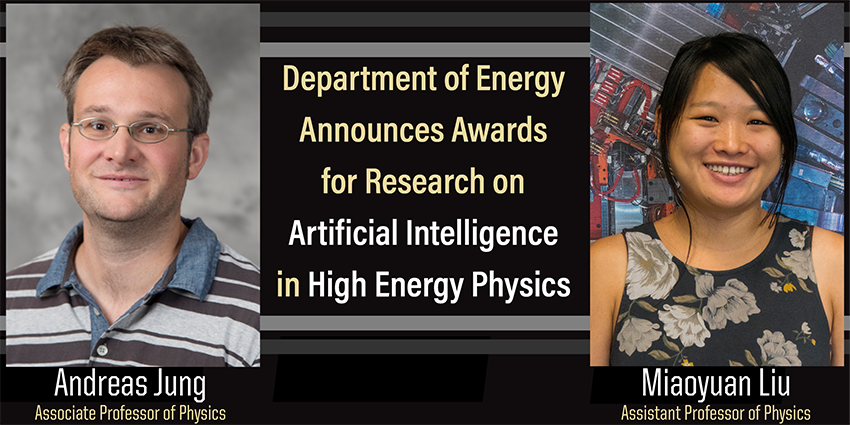Purdue physicists awarded DOE grant for high energy physics and artificial intelligence
2022-12-01

This award will allow the Purdue team to observe - for the first time - the quantum entanglement of top quarks
The United States Department of Energy announced Tuesday that they have awarded $4.3 million for research on artificial intelligence in high energy physics. $290,000 of this award has been granted to researchers at Purdue Physics and Astronomy to pursue Machine Learning techniques for measuring quark data the Large Hadron Collider (LHC), CERN.
This award was granted to Dr. Andreas Jung, associate professor, and Dr. Miaoyuan Liu, assistant professor, both of the Purdue University Department of Physics and Astronomy. The award will disperse over three years.
This highly competitive grant supports the DOE Office of Science initiative in artificial intelligence research to use AI techniques to deliver scientific discoveries that would not otherwise be possible, and to broaden participation in high energy physics research.
“AI and Machine Learning techniques in high energy physics are vitally important for advancing the field,” said Gina Rameika, DOE Associate Director of Science for High Energy Physics. “These awards represent new opportunities for university researchers that will enable the next discoveries in high energy physics.”
According to the Jung, the funding will be used to create AI that will allow for precise measuring of top quark properties at the Large Hadron Collider.
“We propose to use Machine Learning to address a few major systematic uncertainty sources such as imperfect top quark reconstruction, limited sample sizes of simulation samples with alternate parameter settings,” says Jung in the abstract submitted to the DOE. “In particular, we will reduce top quark systematic uncertainties with improved top quark reconstruction with interpretable GNN methods, accessible systematic variations with neural network approximators, and computationally viable matrix element method enabled by differential programming.”
“It will be very interesting to apply our recent work on interpretable and trustworthy geometric learning techniques developed at Purdue, to study the heaviest particle ever observed, and to test quantum effects at an extreme energy scale,” says Liu.
Jung says this this grant has many exciting prospects. Cutting-edge artificial intelligence and machine learning techniques will be applied to harvest the full wealth of data collected at the Large Hadron Collider.
“The DOE seed grant provides the means to substantially improve the precision with which top quarks can be measured in proton-proton collisions,” says Jung. “The application of these new techniques will allow the Purdue team to observe - for the first time - the quantum entanglement of top quarks. Once the full data set of the high-luminosity LHC is collected the Jung group will use the data to show the violation of Bell's inequality. Both are real effects in the quantum mechanical world and have been at the heart of this year's Nobel Prize award in Physics on Quantum Information Science.”
About the Department of Physics and Astronomy at Purdue University
Purdue Department of Physics and Astronomy has a rich and long history dating back to 1904. Our faculty and students are exploring nature at all length scales, from the subatomic to the macroscopic and everything in between. With an excellent and diverse community of faculty, postdocs, and students who are pushing new scientific frontiers, we offer a dynamic learning environment, an inclusive research community, and an engaging network of scholars.
Physics and Astronomy is one of the seven departments within the Purdue University College of Science. World-class research is performed in astrophysics, atomic and molecular optics, accelerator mass spectrometry, biophysics, condensed matter physics, quantum information science, particle and nuclear physics. Our state-of-the-art facilities are in the Physics Building, but our researchers also engage in interdisciplinary work at Discovery Park District at Purdue, particularly the Birck Nanotechnology Center and the Bindley Bioscience Center. We also participate in global research including at the Large Hadron Collider at CERN, Argonne National Laboratory, Brookhaven National Laboratory, Fermilab, the Stanford Linear Accelerator, the James Webb Space Telescope, and several observatories around the world.
Contributors:
Writer: Cheryl Pierce, Communications Specialist for the Purdue University Department of Physics and Astronomy
Andreas Jung, Associate Professor of Physics and Astronomy
Miaoyuan Liu, Assistant Professor of Physics and Astronomy
Links to supporting materials:
https://arxiv.org/pdf/2201.12987.pdf
https://arxiv.org/abs/2210.16966